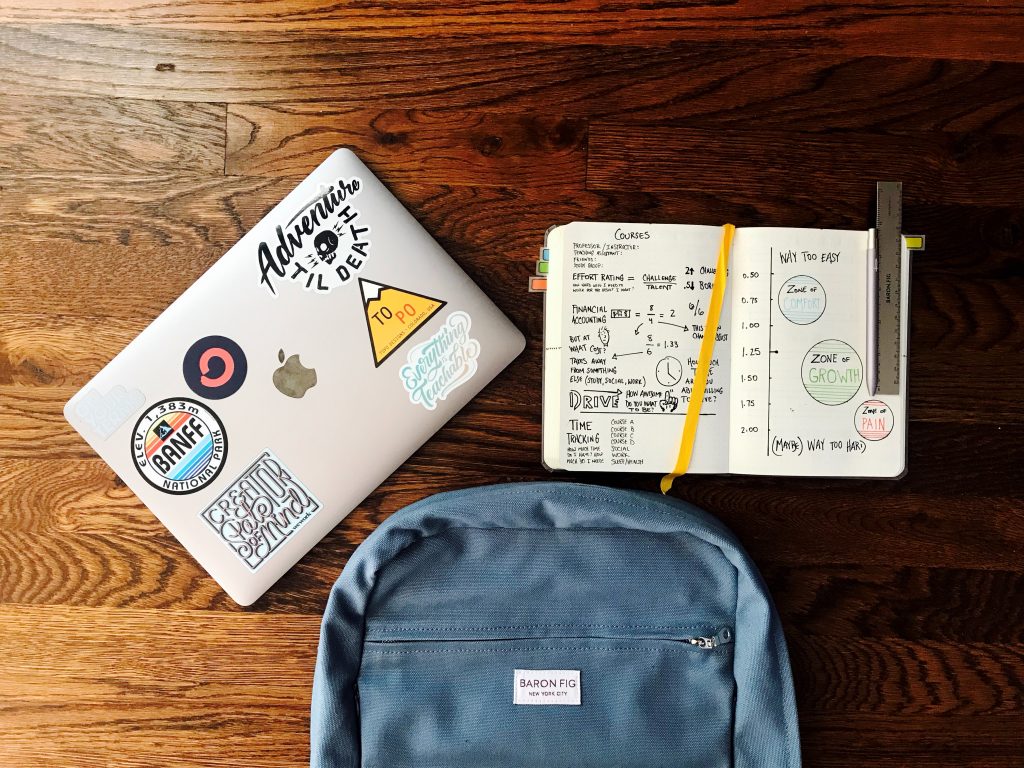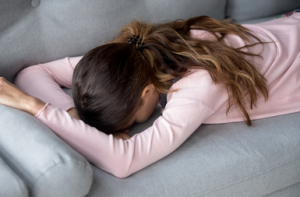Keeping Teen Depression at Bay: 100 Ways to Boost Your Mood
If you are in Canada or anywhere in the Northern hemisphere, the change of season is in full swing – along with the increased likelihood of falling into depression. There are less daylight hours and gone are the freedoms of summer until next year. The stress of being back to school combined with the colder dark days hits hard for many teens.
This is not always the case, some of you might be welcoming the routine, knowing what to expect, and activities and things to keep you occupied. But if you have been finding yourself feeling a little more sad, irritated, angry, or stressed, or know you could easily slip into one of these, this article is for you.

Photo by Anthony Tran on Unsplash
Be sure to scroll to the bottom to get your printable version of the 100 ways to boost your mood and keep depression at bay.
Get your printable PDF here: 100 Ways to Boost Your Mood – for Teen Girls.
The weather change and back to school routine are just some reasons you might be feeling low. Sometimes you might not even be totally aware of what’s leading to that down feeling, but you know how hard it is to get motivated to do anything. It can seem impossible to want to take action even if you know those things will make you feel better.
When I get in a slump, it can be really hard to do my workouts even if I know in my brain how good I will feel afterwards. I’ve come to learn that oftentimes the more I’m resisting doing something, the more I really need to be doing that thing.

Photo by Daniil Kuželev on Unsplash
Things can quickly spiral into that bummed out dark place. Like if you’re feeling more and more tired, your emotions might feel like they are rollercoasting or flatlining into numbness. The idea of picking yourself up and doing something to change how you feel can truly be a challenge, even down to showering, eating, reaching out to a friend, doing something fun or active, etc.
And even though it might seem like turning around the Titanic when it comes to boosting your mood when you’re feeling depressed, there’s a reason why it’s so important to take action to lift your spirits. Because what you do is what gets set into your habits and what you think is what gets patterned into your brain. The brain loves the path of least resistance, so if you constantly give it low, sad, depressed, unmotivated energy and motions, that’s going to be your brain’s go to and what it will want to continue.
On the other hand, the more you give yourself that boost – doing and trying things that lift your mood – the more your brain and body are going to want to do those things, bringing more joy, love, excitement and contentment into your life.
It doesn’t mean you’re not ever going to feel sad, crappy, or depressed sometimes. It doesn’t mean it’s not going to be hard to get up and do that thing. However, I have compiled a list of 100 things that can help boost your mood out of feelings of depression. You can use this as a quick reference guide to go back to…
Pick 3-4 to try each week or pick your top 10 and do those consistently over this month. I really hope you will see a positive difference in your life!
- Move your body for 20 minutes today
- Hang out with someone you like
- Help someone out
- Get some more sleep – try a 20 minute nap or go to bed earlier for the next couple nights
- Eat something that has mood enhancing properties – like berries, bananas, nuts, etc.
- Listen to something funny- funny video, song, podcast
- Call someone who makes you laugh
- Smile- fake it til you make it – science that says boost serotonin and dopamine (feel good endorphins)

Photo by Omid Armin on Unsplash
- Think of something you are looking forward to in the next week/month/year
- Remember a happy memory
- Try a self-compassion exercise
- Spend time cuddling with an animal
- Go for a drive and just take in sights
- Sign up for something new (class, webinar, activity, club at school, etc.)
- Volunteer – giving back makes us feel good.
- Dance
- Eat some chocolate – Go dark for this one.
- Create a bucket list or a list of things you’ve never done but would like to and choose one thing to go and do
- Go outdoors in nature
- Ask a friend to make plans for a future date
- Make a happy or mood lifting music playlist
- Take an amazing selfie
- Go back and do something that you used to enjoy when you were younger
- Go see a movie – preferably something inspiring or funny
- Read a book
- Draw something
- Make art (paint, sculpting, collage, etc.)
- Call someone you haven’t spoken to in a long time (e.g. aunt, friend) and ask them about their day
- Write down some affirmations
- Make your own list of mood boosting ideas
- Go shopping
- Put on your favourite outfit and go out
- Go to a party
- Organize or plan a party
- Play a sport
- Do something kind for someone else unexpectedly
- Read poetry
- Write poetry
- Do something thrill seeking (e.g. roller coasters, mountain biking, ice climbing, cave diving, hot air balloon, etc.)
- Go to a pet store and pet the cutest furry fluffy critters you can find
- Write a letter to your future self
- Do a series of pushups, situps, squats and lunges for 90 seconds each
- Look in the mirror and say 3 nice things about yourself
- Get a spa treatment (e.g. massage, manicure, pedicure)
- Go to a laughter yoga class
- Go to a regular yoga class
- Do something a little extravagant (e.g. expensive dinner, rent a limo, wear something nice, splurge on something)
- Give/get a hug

Photo by Priscilla Du Preez on Unsplash
- Snuggle a baby
- Play with a younger cousin/sibling
- Do something physically vigorous like a run or hike
- Offer yourself words of encouragement
- Go for ice cream or another delicious treat
- Give someone a compliment
- Make a list of things you’d things you like to do today and knock them off celebrating each one you get to
- Research your dream career
- Have a meal with people you enjoy
- Book a session with a therapist or teen life coach
- Play a game
- Cook a nice meal
- Ask 3 people what they like about you
- Listen to inspiring videos
- Watch funny memes
- Make a video
- Set a 28 day challenge
- Go into a crystal shop and pick out one that speaks to you
- Journal your feelings, hopes, and dreams
- Use a mood tracking app everyday for the week
- Garden or do something that has you getting your hands dirty
- Read a book from your childhood
- Learn something new
- Run some stairs for 5 minutes
- Buy a inexpensive gift card to your favourite treat place and give it to the next person in line
- Start a gratitude journal/list
- Download and start on an acts of kindness calendar
- Create a dance routine with a friend
- Write a song
- Make up the most outrageous touchdown celebration move
- Flip through a fashion magazine and snapshot your favourite outfits
- Find someone famous who looks like you
- Check out this calendar to download all kinds of action calendars to boost happiness and download the app
- Watch a ted talk on happiness
- Clean out your closet or another space
- Show love to someone your care about
- Write a thank you letter to someone (you can send or not)
- Tackle a to do list
- Drink plenty of water

Photo by quokkabottles on Unsplash
- Meditate
- Organize something
- Find, printout, write out quotes that you like and make them visible
- Scrapbook a favourite memory
- Sing
- Make a new friend
- Give something up
- Try a new wellness app
- Play video games
- Write down a list of your strengths and qualities
- Create a vision board where you imagine your ideal self/ideal life-
- Use mental vacation technique (imagine a favourite place- imaginary or real and take it in through all your senses – what you see, hear, feel, smell, and taste).
- Use your posture to boost confidence and mood.
Love,
Chantal
 Chantal Côté (she/her) is a psychologist and teen life coach living in Calgary, Alberta. After over a decade in non-profit and community mental health, Chantal started Pyramid Psychology, a practice dedicated to supporting teens – a population she is constantly amazed by. Chantal is on a mission to help 100,000 teen girls (and their parents) build bulletproof mindsets so they can weather the ups and downs of life. As part of this goal, Chantal has had the privilege of speaking at various events – virtual and live – to support teens and parents.
Chantal Côté (she/her) is a psychologist and teen life coach living in Calgary, Alberta. After over a decade in non-profit and community mental health, Chantal started Pyramid Psychology, a practice dedicated to supporting teens – a population she is constantly amazed by. Chantal is on a mission to help 100,000 teen girls (and their parents) build bulletproof mindsets so they can weather the ups and downs of life. As part of this goal, Chantal has had the privilege of speaking at various events – virtual and live – to support teens and parents.
Outside of this passion, Chantal is often in nature, writing poetry, playing ball hockey and hanging out with her loved ones.
Each week, Chantal writes a blog article in response to issues she hears from the parents and teens she connects with. If you have something you’d like to read more on – email ideas and questions to info@pyramidpsychology.com or DM us via Instagram or Facebook.












 Jessa is a counsellor that has recently completed her master of counselling degree through Athabasca University.
Jessa is a counsellor that has recently completed her master of counselling degree through Athabasca University.












































